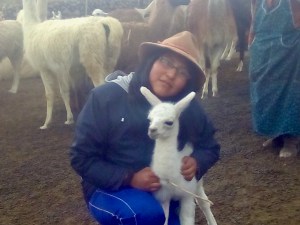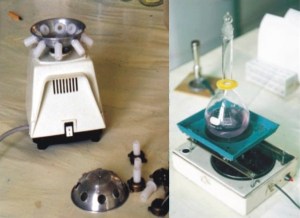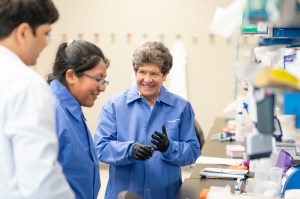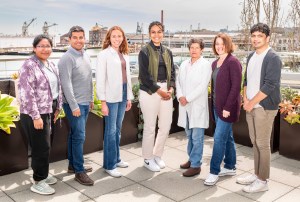Obsessed with the nucleus
CZ Biohub San Francisco Investigator Hawa Racine Thiam’s new Stanford lab applies physics to the study of cells and their nuclei
In “Catalysts of Change” we highlight infectious disease scientists from across the world working to build research capacity locally and globally as recipients of grants from the Chan Zuckerberg Initiative and the Bill & Melinda Gates Foundation. CZ Biohub San Francisco’s Rapid Response group works with these teams to launch their metagenomic sequencing programs, then continues to support the groups as they become independent and train others.
When the COVID-19 pandemic hit Bolivia in 2020, Belén Choque was an undergraduate student living in La Paz. Like everyone else, she was forced to adapt to remote classes and missed out on social interaction with peers and professors. Unlike most college students, however, Choque was determined to get involved in the response to COVID-19.
Choque had a special interest in infectious diseases. Growing up, she would visit her grandparents’ llama and alpaca farm in the Bolivian highlands. These animals, part of a biological family known as camelids, are a key part of Bolivia’s culture and history, and play a significant role in the economic and social well-being of rural families. However, they can be susceptible to seasonal infections that cause diarrhea. Choque knew how rapidly these infections could spread among the camelids, and the zoonotic spillover risk they posed to the humans working with them. This experience led her to major in biology at Universidad Mayor de San Andrés (UMSA), where she became interested in the interface between human and environmental networks of transmission.

Belén Choque with a newborn llama on her grandparents’ farm in Santiago de Machaca, Bolivia. Belén plans to return here to collect samples for her new research. (Courtesy of Belén Choque.)
During her final year of college in 2021, with COVID showing no signs of receding, Choque got her chance to contribute to the pandemic response: an opportunity to work on the molecular epidemiology of SARS-CoV-2 in the lab of Volga Iñiguez at UMSA.
Iñiguez studies the molecular biology of viruses, and at the onset of the pandemic, she was perfectly positioned to study SARS-CoV-2. While the significance of her field of study is now well understood, that wasn’t always the case. “There were hardly any groups studying viruses in Bolivia back then,” she recalls. As a result, she ended up pursuing a Ph.D. in the United States, at the University of Wisconsin–Madison.
After completing her doctorate, Iñiguez returned to Bolivia to set up her own lab. This was not without its challenges: as a percentage of gross domestic product, Bolivia spends less than a tenth of what the U.S. does on research and development. Not only does this mean fewer researchers and grants, it also means limited access to the basics of running a lab, including equipment and reagents. “But I was stubborn and wanted to make it work,” she says. In the early days of setting up her lab, Iñiguez recalls, she needed to repurpose a kitchen blender to use as a centrifuge, turn a record turntable into a flask shaker, and use acupuncture needles as electrodes to run gel electrophoresis.

A centrifuge (left) made from a kitchen blender, and record turntable repurposed as a cell shaker (right) in the lab of Volga Iñiguez. (Photos: Nataniel Mamani/UMSA.)
This resourcefulness enabled the lab to make significant contributions to research and public health. Early in her career, Iñiguez’s work helped identify rotavirus as a cause of acute gastroenteritis, an intestinal infection connected to the high child mortality rate in Bolivia. Her lab’s work supported the World Health Organization’s Expanded Programme on Immunization (EPI) to establish a national disease surveillance program in Bolivia and led to changes in how acute gastroenteritis is treated in pediatric hospitals. Together, Iñiguez and EPI’s advocacy for a widespread vaccination campaign led to Bolivia being one of the first countries where a rotavirus vaccine was introduced. Rotavirus vaccination campaigns have since been successfully implemented in other countries.
Teaching and mentorship have also been essential components of Iñiguez’s research. “It’s a team—we work together,” she says, referring to her students and lab technicians. “Without them, we wouldn’t move an inch.”
One of Iñiguez’s former students, Sergio Gutiérrez-Cortez, recalls taking her class as an undergraduate student in the 2000s. “She’s been an inspiration,” he says. After graduating from UMSA with a degree in biology—including a year of research in Iñiguez’s lab—Gutiérrez-Cortez decided to pursue a Ph.D. There were no suitable programs in Bolivia at the time, but he received a prestigious DAAD scholarship to study at the University of Chile. Gutiérrez-Cortez later returned to Bolivia to work in UMSA’s Department of Environmental Microbiology, this time as a colleague to Iñiguez and leading his own lab.
At the start of the COVID-19 pandemic, Iñiguez began examining the diversity and distribution of SARS-CoV-2 variants in Bolivia, the project Choque joined. For a researcher working in a biotech hub like San Francisco or Boston, this would likely involve next-generation sequencing (NGS) of SARS-CoV-2 isolates. But for Iñiguez, it meant settling for Sanger sequencing, an old-school method that looks at a single viral fragment at a time, as opposed to NGS, which looks at millions simultaneously. The Sanger method nonetheless proved to be valuable, and helped confirm that the variants seen in Bolivia were consistent with those being found in the rest of the world.
For Iñiguez, though, this experience further highlighted the gap in research infrastructure between Bolivia and the U.S.—her lab was just one of a few in the country able to generate this data. Pandemics are global, but the infrastructure to study and respond to them is not.

CZ Biohub SF scientist Gowtham Thakku (left) works with Belén Choque and Volga Iñiguez to prepare samples for sequencing. (Credit: Kevin Meynell)
Iñiguez is now collaborating with the Rapid Response group at CZ Biohub SF to establish metagenomic next-generation sequencing (mNGS) capacity in her lab at UMSA. She plans to use mNGS to determine the diversity of viruses circulating in humans and in wild and domestic mammals in two highly contrasting geographic regions in Bolivia: the Amazon and the Andean Highlands. As Choque’s childhood experience at her grandparents’ llama farm highlights, emerging infectious diseases from zoonotic pathogens are a major public health threat locally and globally.
In April, Choque, Gutiérrez-Cortez, and Iñiguez visited the Biohub in San Francisco. During this time, they worked on wet-lab methods for preparing samples for sequencing, as well as bioinformatics analysis using Chan Zuckerberg ID, a free, cloud-based mNGS software platform, to identify pathogens. The team of Bolivian scientists, who collectively spanned three generations of researchers, also met with UC Berkeley and UC San Francisco researchers, planting seeds for potential collaborations. In the next few months, the first NGS sequencing instrument is expected to be delivered to Iñiguez’s lab. Soon after, her team hopes to begin performing mNGS in-house.

Belén Choque, Sergio Gutiérrez-Cortez, Rebecca Gowen, Honey Mekonen, Volga Iñiguez, Cristina Tato, and Gowtham Thakku at CZ Biohub SF. (Credit: Kevin Meynell)
But their ambitions extend wider. Iñiguez and Gutiérrez-Cortez look forward to training the next generation of scientists in Bolivia with the newest technologies and methods. This year, UMSA will launch a Ph.D. program in biological sciences—the first of its kind in the country. The program aims to strengthen the local scientific workforce and use research and innovation to address social, economic, and technological challenges facing Bolivia. Iñiguez and Gutiérrez-Cortez are part of the core team that will support this program. Choque, who started out as an undergraduate in Iñiguez’s lab, is now enrolled in a Master’s program and has begun making exploratory trips to the Bolivian highlands and Amazon to collect samples for metagenomic sequencing.
The globalization of science is underway.
Thakku and Gowen are members of CZ Biohub SF’s Rapid Response Team.
CZ Biohub San Francisco Investigator Hawa Racine Thiam’s new Stanford lab applies physics to the study of cells and their nuclei
Learn More
Using frogs as a model organism, CZ Biohub SF Investigator Helen Willsey is revealing surprising connections between autism and hair-like structures on the...
Learn More
CZ Biohub SF-backed NextGen initiative succeeds in diversifying faculty hiring in biological and biomedical sciences at major Bay Area universities
Learn More
Stay up-to-date on the latest news, publications, competitions, and stories from CZ Biohub.
Cookies and JavaScript are required to access this form.